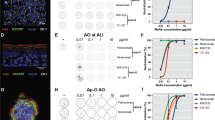Abstract
To investigate the association among RANTES (regulated on activation normal T cell expressed and secreted) gene promoter polymorphism, serum RANTES levels, and recurrent wheezing after RSV (respiratory syncytial virus) bronchiolitis in children (1–12 months of age) from Han, Southern china. Three hundred twenty children with RSV bronchiolitis and 272 controls were enrolled in the 3-year follow-up study. The polymerase chain reaction–restriction fragment length polymorphism (PCR-RELP), enzyme-linked immunosorbent assay (ELISA) kit and luciferase analysis were the mainly used methods, which were used to genotype the RANTES (−403G/A), assess the serum RANTES levels and the RANTES promoter activity. As the results showed, the RANTES (−403 G/A) in the promoter region was associated with recurrent wheezing after RSV bronchiolitis (p < 0.05) and serum RANTES levels (RANTES genotype G/G: 26.03 ± 7.46 ng/ml G/A: 28.22 ± 6.44 ng/ml A/A: 30.12 ± 5.88 ng/ml). Functional analyses of RANTES promoter activity indicated that the RANTES (−403 G to A) mutation increases the transcriptional activity of the RANTES promoter. In conclusion, the RANTES (−403 G/A) polymorphism increases RANTES transcriptional activity resulted in a high serum RANTES levels, thus increased the risk of recurrent wheezing after RSV bronchiolitis.

Similar content being viewed by others
Abbreviations
- RANTES:
-
regulated on activation normal T cell expressed and secreted
- RSV:
-
respiratory syncytial virus
- PCR-RELP:
-
polymerase chain reaction–restriction fragment length polymorphism
- ELISA:
-
enzyme-linked immunosorbent assay
- IRF:
-
interferon response factor
References
Al-Abdulhadi SA, Helms PJ, Main M et al (2005) Preferential transmission and association of the −403 G → A promoter RANTES polymorphism with atopic asthma. Genes Immun 6:24–30
Amanatidou V, Sourvinos G, Apostolakis S et al (2008) RANTES promoter gene polymorphisms and susceptibility to severe respiratory syncytial virus-induced bronchiolitis. The Pediatr Infect Dis J 27:38–42
An P, Nelson GW, Wang L et al (2002) Modulating influence on HIV/AIDS by interacting RANTES gene variants. PNAS 99:10002–10007
Bont L, Heijnen CJ, Kavelaars A et al (2000) Monocyte IL-10 production during respiratory syncytial virus bronchiolitis is associated with recurrent wheezing in a one-year follow-up study. Am J Respir Crit Care Med 161:1518–1523
Everard ML, Milner AD (1992) The respiratory syncytial virus and its role in acute bronchiolitis. Eur J Pediatr 151:638–651
Fryer AA, Spiteri MA, Bianco A et al (2000) The −403 G→A promoter polymorphism in the RANTES gene is associated with atopy and asthma. Genes Immun 1:509–514
Genin P, Algarte M, Roof P et al (2000) Regulation of RANTES chemokine gene expression requires cooperativity between NF-kappa B and IFN-regulatory factor transcription factors. J Immunol 164:5352–5361
Hajeer AH, al Sharif F, Ollier WE (1999) A polymorphism at position −403 in the human RANTES promoter. Eur J Immunogenet 26:375–376
Hull J, Thomson A, Kwiatkowski D (2000) Association of respiratory syncytial virus bronchiolitis with the interleukin 8 gene region in UK families. Thorax 55:1023–1027
Ichinohe S, Hussain IR, Johnston SL (2003) Cytokine production of RSV/PHA-stimulated tonsillar mononuclear cells: influences of age and atopy. Eur Respir J 22:317–322
John AE, Berlin AA, Lukacs NW (2003) Respiratory syncytial virus-induced CCL5/RANTES contributes to exacerbation of allergic airway inflammation. Eur J Immunol 33:1677–1685
Kotaniemi-Syrjanen A, Reijonen TM, Korhonen K et al (2002) Wheezing requiring hospitalization in early childhood: predictive factors for asthma in a six-year follow-up. Pediatr Allergy Immunol 13:418–425
Liu H, Chao D, Nakayama EE et al (1999) Polymorphism in RANTES chemokine promoter affects HIV-1 disease progression. PNAS 96:4581–4585
Martinez FD (2003) Respiratory syncytial virus bronchiolitis and the pathogenesis of childhood asthma. The Pediatr Infect Dis J 22:S76–S82
Martinez FD, Wright AL, Taussig LM et al (1995) Asthma and wheezing in the first six years of life. The Group Health Medical Associates. The New Engl J Med 332:133–138
Meurer R, Van Riper G, Feeney W et al (1993) Formation of eosinophilic and monocytic intradermal inflammatory sites in the dog by injection of human RANTES but not human monocyte chemoattractant protein 1, human macrophage inflammatory protein 1 alpha, or human interleukin 8. The J Exp Med 178:1913–1921
Murai H, Terada A, Mizuno M et al (2007) IL-10 and RANTES are elevated in nasopharyngeal secretions of children with respiratory syncytial virus infection. Allergol Int 56:157–163
Nickel RG, Casolaro V, Wahn U et al (2000) Atopic dermatitis is associated with a functional mutation in the promoter of the C–C chemokine RANTES. J Immunol 164:1612–1616
Schaap T (1980) The applicability of the Hardy–Weinberg principle in the study of populations. Ann Hum Genet 44:211–215
Schall TJ (1991) Biology of the RANTES/SIS cytokine family. Cytokine 3:165–183
Schall TJ, Bacon K, Toy KJ et al (1990) Selective attraction of monocytes and T lymphocytes of the memory phenotype by cytokine RANTES. Nature 347:669–671
Sigurs N, Bjarnason R, Sigurbergsson F et al (2000) Respiratory syncytial virus bronchiolitis in infancy is an important risk factor for asthma and allergy at age 7. Am J Respir Crit Care Med 161:1501–1507
Sigurs N, Gustafsson PM, Bjarnason R et al (2005) Severe respiratory syncytial virus bronchiolitis in infancy and asthma and allergy at age 13. Am J Respir Crit Care Med 171:137–141
Tekkanat KK, Maassab H, Miller A et al (2002) RANTES (CCL5) production during primary respiratory syncytial virus infection exacerbates airway disease. Eur J Immunol 32:3276–3284
Yao TC, Kuo ML, See LC et al (2003) The RANTES promoter polymorphism: a genetic risk factor for near-fatal asthma in Chinese children. The J Allergy Clin Immunol 111:1285–1292
Acknowledgment
This study was supported by Foundation of Nan**g Municipal Health Bureau (YKK05121).
Author information
Authors and Affiliations
Corresponding author
Additional information
Man Tian and Feng Liu contributed equally to this work.
Rights and permissions
About this article
Cite this article
Tian, M., Liu, F., Wen, Gy. et al. Effect of variation in RANTES promoter on serum RANTES levels and risk of recurrent wheezing after RSV bronchiolitis in children from Han, Southern China. Eur J Pediatr 168, 963–967 (2009). https://doi.org/10.1007/s00431-008-0870-3
Received:
Accepted:
Published:
Issue Date:
DOI: https://doi.org/10.1007/s00431-008-0870-3




